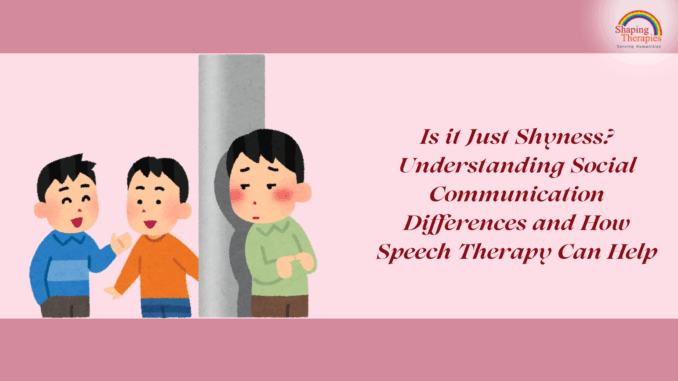
Does your child often hang back in group settings, seem hesitant to speak, or prefer playing alone? While it may seem like typical shyness, there could be more beneath the surface. Understanding whether your child is simply shy or experiencing social communication differences is key to helping them build meaningful relationships and succeed in social settings.
Shyness is a common personality trait, often characterized by hesitation or discomfort in social environments. Many shy children warm up over time, especially when they feel safe and supported. But when communication challenges persist even in familiar situations, it may be time to consider if deeper social communication difficulties are involved.
Social communication refers to how children use language and behavior to interact with others. It includes understanding tone, facial expressions, body language, and the unspoken “rules” of conversations. Children with social communication differences often struggle with these aspects, not because they’re shy, but because they don’t instinctively grasp the nuances that others take for granted.
At Shaping Therapies in Powai, we specialize in identifying and addressing these challenges through personalized speech therapy for social communication. Our approach is gentle, evidence-based, and child-focused, helping children become more confident and connected.
Shyness vs. Social Communication Differences
Shyness is a personality trait characterized by discomfort or inhibition in social situations. Often, shy children can overcome this hesitancy with familiarity and a supportive environment. In contrast, social communication differences involve fundamental difficulties with the intricate rules of social interaction. This can manifest in challenges with:
-> Understanding non-verbal cues like body language and facial expressions.
-> Interpreting the unspoken context and implied meanings in conversations.
-> Initiating and maintaining conversations in a reciprocal manner.
-> Recognizing and respecting conversational turn-taking and flow.
-> Adapting language use appropriately for different social situations and audiences.
| Aspect | Shyness | Social Communication Differences |
| Motivation to interact | Wants to engage but feels nervous | May lack understanding of how to interact |
| Familiarity helps? | Improves with known people | Challenges persist regardless of familiarity |
| Underlying issue | Emotional discomfort | Skill-based difficulty in social language |
| Impact | Usually mild, short-term | Can affect school, friendships, self-esteem |
Differentiating Shyness from Social Communication Disorders
| Aspect | Shyness | Social Communication Disorder |
| Nature | A normal personality trait marked by hesitation in social settings | A developmental condition involving persistent challenges with social use of language |
| Communication Style | May speak less or appear nervous, but can communicate effectively | Often uses language in unusual ways or has trouble understanding how to communicate in context |
| Social Understanding | Understands social rules but may feel anxious applying them | Struggles to understand or follow basic social rules and cues |
| Consistency of Behavior | Behavior improves with familiarity and encouragement | Difficulties are consistent across different people and environments |
| Interaction with Peers | Wants to interact but holds back due to anxiety | May not know how to engage or respond appropriately in social interactions |
| Misunderstandings | Occasional, based on nerves or unfamiliarity | Frequent, due to lack of comprehension of instructions or social cues |
| When to Seek Help | If shyness severely impacts daily functioning over time | If challenges are persistent, interfere with communication, and don’t improve with age or exposure |
Why This Difference Matters
-> Shyness may benefit from gentle exposure and encouragement
-> Social communication challenges need targeted therapy
-> Early support leads to stronger long-term outcomes
-> Understanding the difference prevents mislabeling and missed support
Common Signs of Social Communication Differences
- Difficulty initiating or maintaining conversations
- Struggles to understand jokes, tone, or facial expressions
- Trouble making or keeping friends
- Speaks out of turn, interrupts, or avoids eye contact
- Uses language that feels awkward or off in social settings
When parents recognize these signs and seek help early, children can receive the support they need to thrive socially and emotionally.
How Speech Therapy Helps at Shaping Therapies, Powai
Our speech-language pathologists begin with a comprehensive assessment to understand your child’s strengths and needs. From there, we create a customized therapy plan tailored to your child’s developmental level and goals.
Evidence-Based Techniques We Use:
-> Social skills training – teaching interaction rules and expectations
-> Pragmatic language therapy – developing functional social language
-> Role-playing – practicing real-life social scenarios
-> Visual supports – helping children decode non-verbal cues
-> Video modeling – learning by observing successful peer interactions
Beyond therapy sessions, we empower families with home strategies and consistent collaboration to reinforce learning and build progress over time.
When to Seek Professional Help
-> Persistent quietness that affects friendships or learning
-> Lack of improvement despite familiarity or encouragement
-> Ongoing confusion or misinterpretation during conversations
-> Difficulty reading non-verbal cues or responding appropriately
-> Gut instinct that something beyond shyness is going on
If you’re unsure whether your child’s behavior is simply shy or something more, you’re not alone. At Shaping Therapies in Powai, we help parents find clarity and provide children with tools to succeed socially. Our team of experienced therapists is here to guide your child’s communication journey with compassion and expertise.
Conclusion
Recognizing the difference between shyness and social communication differences can be the key to unlocking a child’s social potential. While shyness often fades, social communication challenges benefit greatly from early and targeted intervention. Speech therapy offers practical solutions and skills that empower children to build relationships, participate in school, and engage confidently with the world.If you’re ready to explore how speech therapy can help your child, contact Shaping Therapies, Powai today. We’re here to support your family every step of the way.

Leave a Reply